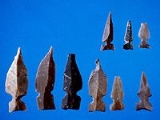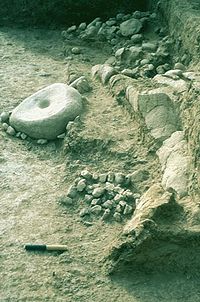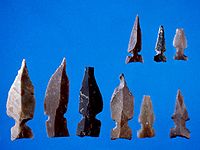
Gesher archaeological site
Encyclopedia


Nahal Tavor
Nahal Tavor , lit. Tabor Stream, is an intermittent stream in the lower Galilee, Israel.-Geography:The stream starts in the hills of Nazareth, east of the city, and runs east and south of Mount Tabor, where it turns east and then empties into the Jordan River between Gesher and Belvoir...
, near kibbutz Gesher
Gesher, Israel
Gesher is a kibbutz in the Beit She'an Valley in northeastern Israel. Founded in 1939 by immigrants from Germany, it falls under the jurisdiction of Valley of Springs Regional Council. It is situated 10 km south of kibbutz Deganya Aleph and 15 km south of Tiberias. The population is...
in the central Jordan Valley
Jordan Valley (Middle East)
The Jordan Valley forms part of the larger Jordan Rift Valley. It is 120 kilometers long and 15 kilometers wide, where it runs from Lake Tiberias in the north to northern Dead Sea in the south. It runs for an additional 155 kilometer south of the Dead Sea to Aqaba, an area also known as Wadi...
of Israel
Israel
The State of Israel is a parliamentary republic located in the Middle East, along the eastern shore of the Mediterranean Sea...
. It bears signs of occupation from two periods, the very early Neolithic and the Middle Bronze Age. The site was first excavated between 1986 and 1987 by Yosef Garfinkel
Yosef Garfinkel
Yosef Garfinkel is a professor of Prehistoric Archaeology and of Archaeology of the Biblical Period at the Hebrew University of Jerusalem.-Biography:...
of the Hebrew University of Jerusalem
Hebrew University of Jerusalem
The Hebrew University of Jerusalem ; ; abbreviated HUJI) is Israel's second-oldest university, after the Technion – Israel Institute of Technology. The Hebrew University has three campuses in Jerusalem and one in Rehovot. The world's largest Jewish studies library is located on its Edmond J...
and between 2002 and 2004 by Susan Cohen of Montana State University. The average of 4 Radiocarbon dating
Radiocarbon dating
Radiocarbon dating is a radiometric dating method that uses the naturally occurring radioisotope carbon-14 to estimate the age of carbon-bearing materials up to about 58,000 to 62,000 years. Raw, i.e. uncalibrated, radiocarbon ages are usually reported in radiocarbon years "Before Present" ,...
results suggested inhabitation of the settlement around 8000 BC.
During the Pre-Pottery Neolithic A
Pre-Pottery Neolithic A
Pre-Pottery Neolithic A denotes the first stage in early Levantine Neolithic culture, dating around 9500 to 8500 BC. Archaeological remains are located in the Levantine and upper Mesopotamian region of the Fertile Crescent...
the site was a small village composed of a few rounded structures. Typical flint
Flint
Flint is a hard, sedimentary cryptocrystalline form of the mineral quartz, categorized as a variety of chert. It occurs chiefly as nodules and masses in sedimentary rocks, such as chalks and limestones. Inside the nodule, flint is usually dark grey, black, green, white, or brown in colour, and...
finds included a high number of el-Khiam
Khiamian
The Khiamian is a period of the Near-Eastern Neolithic, marking the transition between the Natufian and the Pre-Pottery Neolithic A...
points which Garfinkel argued, along with the relatively early date could class Gesher as a Khiamian site. One outstanding discovery, unknown from any other Neolithic
Neolithic
The Neolithic Age, Era, or Period, or New Stone Age, was a period in the development of human technology, beginning about 9500 BC in some parts of the Middle East, and later in other parts of the world. It is traditionally considered as the last part of the Stone Age...
site of the period in the Near East
Near East
The Near East is a geographical term that covers different countries for geographers, archeologists, and historians, on the one hand, and for political scientists, economists, and journalists, on the other...
, is a workshop for the production of basalt artifacts
Artifact (archaeology)
An artifact or artefact is "something made or given shape by man, such as a tool or a work of art, esp an object of archaeological interest"...
. The workshop produced basalt axes and various other tools which were then sent to other early Neolithic centers, such as Jericho
Jericho
Jericho ; is a city located near the Jordan River in the West Bank of the Palestinian territories. It is the capital of the Jericho Governorate and has a population of more than 20,000. Situated well below sea level on an east-west route north of the Dead Sea, Jericho is the lowest permanently...
and Netiv Hagdud
Netiv HaGdud
Netiv HaGdud is a moshav and Israeli settlement in the West Bank. Located in the Jordan Valley around twenty kilometres north of Jericho, it falls under the jurisdiction of Bik'at HaYarden Regional Council...
. According radiometric dates, Gesher is one of the earliest Neolithic sites in the Near East. During this period the first villages were established and the transition to agriculture occurred. A final excavation report on the Neolithic site was published in 2006.
During the Middle Bronze Age IIA, Gesher served as a cemetery. Some 20 graves have been uncovered. These are shaft graves, dug into the local sediment, used for individual burials and never reopened. This facilitates the study of burial customs, including body position, the quantity of grave goods and their relation to the deceased. Bronze spearheads and axes (including three duck-bill axes) were found in four of the graves. A final excavation report on the Middle Bronze cemetery was published in 2007.

